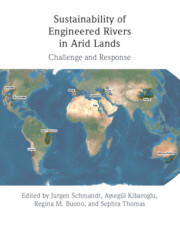Book contents
- Sustainability of Engineered Rivers in Arid Lands
- Sustainability of Engineered Rivers in Arid Lands
- Copyright page
- Dedication
- Contents
- Contributors
- Part I Introduction
- Part II Challenge
- Part III Engineered Rivers
- 7 The Nile River Basin
- 8 The Euphrates–Tigris River Basin
- 9 The Yellow River Basin
- 10 The Murray–Darling River Basin
- 11 The São Francisco River Basin
- 12 The Limarí River Basin
- 13 The Colorado River Basin
- 14 The Rio Grande / Río Bravo Basin
- 15 The Jucar River Basin
- Part IV Response
- Part V Conclusion
- Index
- References
7 - The Nile River Basin
from Part III - Engineered Rivers
Published online by Cambridge University Press: 16 September 2021
- Sustainability of Engineered Rivers in Arid Lands
- Sustainability of Engineered Rivers in Arid Lands
- Copyright page
- Dedication
- Contents
- Contributors
- Part I Introduction
- Part II Challenge
- Part III Engineered Rivers
- 7 The Nile River Basin
- 8 The Euphrates–Tigris River Basin
- 9 The Yellow River Basin
- 10 The Murray–Darling River Basin
- 11 The São Francisco River Basin
- 12 The Limarí River Basin
- 13 The Colorado River Basin
- 14 The Rio Grande / Río Bravo Basin
- 15 The Jucar River Basin
- Part IV Response
- Part V Conclusion
- Index
- References
Summary
The chapter analyzes upstream-downstream issues in the Nile river basin. The large increase in population in the future and the resulting push for development will increase demand of the Nile flow in upstream riparian countries where headwaters are sourced. Variability in temperature and precipitation due to climate change will impact the heavily populated areas the most, which in the case of the Nile, is at the Delta in Egypt. This will have a deep economic impact as Egypt is the most prosperous country along the Nile. However, the increased development and engineering upstream will affect how much of the Nile is available at a specific time for Egypt. These tensions are already seen in the construction of the Grand Ethiopian Renaissance Dam. An agreement still has not been reached as countries are struggling with sharing ownership of the river. If sufficient flow is not released to Egypt, saltwater intrusion in Egypt can endanger current groundwater storage, pushing the country to invest in more desalination.
Keywords
- Type
- Chapter
- Information
- Sustainability of Engineered Rivers In Arid LandsChallenge and Response, pp. 79 - 93Publisher: Cambridge University PressPrint publication year: 2021
References
- 1
- Cited by



